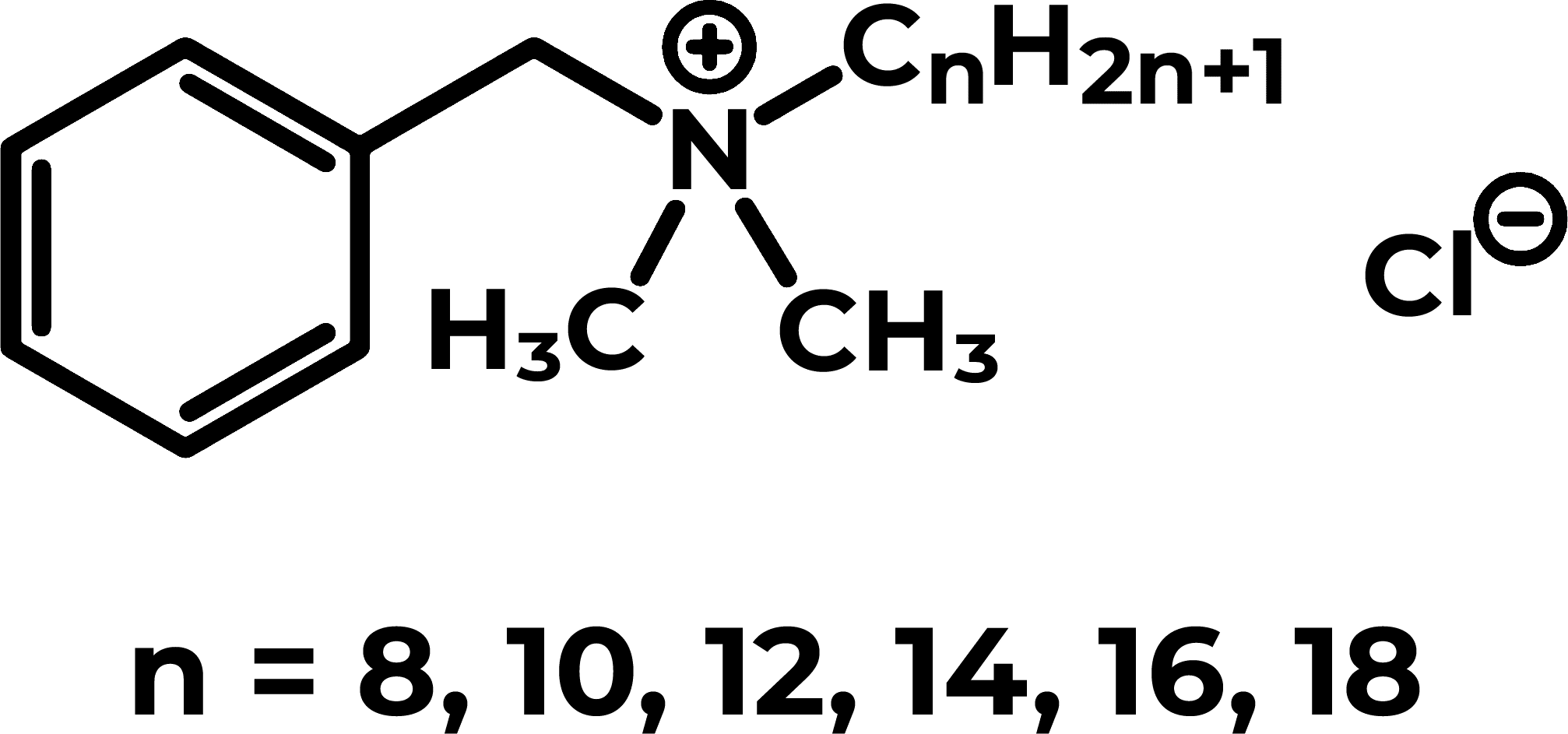#QuatFree
Disinfectants with quaternary ammonium compounds have been linked with some serious negative health outcomes. It’s time to go #QuatFree.
What are quats?

The chemical structure of the quat benzalkonium chloride, also known as alkyldimethylbenzylammonium chloride, ADBAC, and Zephiran.
According to Compendium of Chemical Terminology, quaternary ammonium compounds, also known as QACs or quats, are “derivatives of ammonium compounds, (NH4+)Y–, in which all four of the hydrogens bonded to nitrogen have been replaced with hydrocarbyl groups.” These compounds are used in a variety of applications, including surfactants, fabric softeners, antistatic agents, and, most popularly, disinfectants, although some question whether they should be.
The risks quats pose to humans are significant. The Internationally Peer Reviewed Chemical Safety Information (INCHEM) by the World Health Organization (WHO) highlights the clinical risks quats pose on humans. “Mild to severe caustic burns of the skin and mucous membranes can occur depending on the agent and the concentration. Other signs may include: nausea, vomiting, abdominal pain, anxiety, restlessness, coma, convulsions, hypotension, cyanosis, and apnoea due to respiratory muscle paralysis; death may occur within 1 or 3 hours after ingestion of concentrated solutions.”
In an article on WomensVoices.org, Alex Scranton argues that quat-based disinfectants are “…total overkill for your everyday household cleaning needs. Unless you plan on doing some open-heart surgery on your kitchen table, there is no need for quats to sterilize the surfaces in your house.” She continues in the same vein.
We know from lab testing that quats do effectively kill many kinds of microbes like E. Coli and Staph. Aureus – but there are serious potential side effects that comes along with that power. It’s like killing a housefly with a sledgehammer – there is no question the sledgehammer will be very effective (with a direct hit) but the side effects (the gaping holes in your wall) are pretty unpleasant, not to mention unnecessary… [Q]uats will linger on a surface long after you have cleaned with them. This means that your exposure (and your kids’ exposure, and your pet’s exposure) continues every time you touch that countertop… In the mice experiments… it took months of re-sanitizing the animal cages that had originally been cleaned with quats until the mice were reproducing normally again.
The Heath Risks
Despite their prolific use, quats are associated with many negative health outcomes, including cancer, chronic obstructive pulmonary disease (COPD), asthma, infertility, and birth defects, in addition to nausea, vomiting, abdominal pain, anxiety, restlessness, coma, convulsions, hypotension, cyanosis, apnoea due to respiratory muscle paralysis, and death. Additionally, due to its expansive use, strains of staph found in clinical and food service environments have actually developed resistance to quats. Quats have even been observed wreaking havoc in the microbiomes of water treatment plants and aquatic environments, resulting increased water treatment costs and the killing of organisms downstream.
The 2020 Coronavirus Pandemic has significantly increased the volume of disinfectants used in everyday situations—that change, however, does not come without consequences.
Cancer
In a 2017 article published by Reuters Health, exposure to quats are associated with a 65 percent higher risk of thyroid cancer. According to Reuters, “For people whose jobs might have led to the most cumulative exposure to biocides over time, the odds of thyroid cancer was more than doubled.”
COPD
“Chronic obstructive pulmonary disease (COPD) is a chronic inflammatory lung disease that causes obstructed airflow from the lungs.” (Mayo Clinic) In 2019 study of 73,262 US female nurses, Dumas et al. found continuous exposure to cleaning products and disinfectants was associated with a significantly increased risk of developing COPD, independent of asthma and smoking.
Asthma
In an information sheet published by NYU Grossman School of Medicine, the potential risks of quats is outlined in fine detail. It says, “…exposure to [quats] does have the potential to cause serious and preventable health effects. These may include… triggering of asthma symptoms in people who already have asthma or new onset of asthma in people with no prior asthma.”
Eye Injuries
The risks quats pose on eyes and other mucous membranes is outlined in the same information sheet published by NYU Grossman School of Medicine: “Direct contact with [quats] splashed into the eye or mucous membrane can cause injuries, ranging from short-term irritation to long-term or permanent damage to the cornea.”
Infertility
A 2015 article on NoHarm.org cites a study published in the same year which links household use of quats to infertility, among other conditions: “…Virginia Tech University found that both male and female lab mice exposed to [quats] in their cages presented with impaired fertility, with symptoms such as decreased ovulation and weaker sperm.
Contact Dermatitis
In addition to a myriad of other health risks, the previously referenced NYU Grossman School of Medicine information sheet points out the risk quats pose to the skin. “[Quats] have been reported to cause irritant contact dermatitis through direct injury to the outer skin layers in exposed individuals.”
Bacterial Resistance
In the 1998 article Bacterial resistance to disinfectants containing quaternary ammonium compounds published in International Biodeterioration & Biodegradation, Sundheim et al. describe the resistance to quats in clinical strains of staphylococci. They also found the quat resistance genes were also distributed among staphylococcal strains in the food industry.
Birth Defects
In Common Household Disinfectants Linked with Birth Defects, Miscarriages and Infertility, a study is cited in which rat and mice exposure to quats were associated with neural tube defects. The study began after researchers detected mortality anomalies among rat colonies kept in cages treated with quats.
Environmental Effects
In the 2015 article Quaternary ammonium compounds (QACs): A review on occurrence, fate and toxicity in the environment published in the Science of The Total Environment, Zhang et al. claims the widespread observed presence of quats in the environment could wipe out aquatic organisms, including those microorganisms used in water and wastewater treatment plants.


